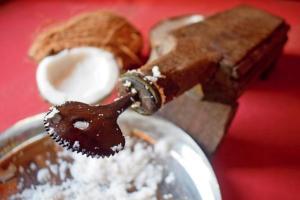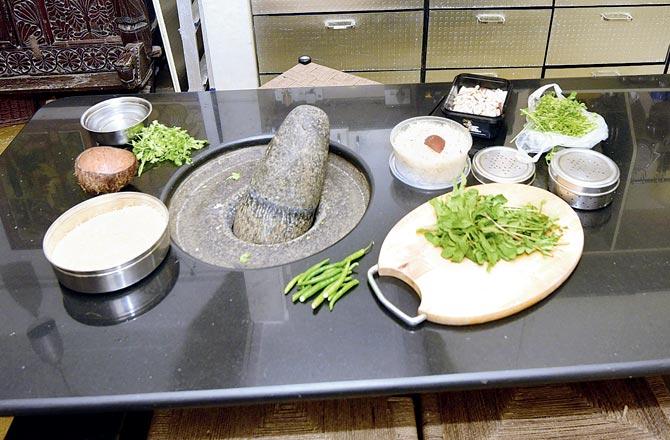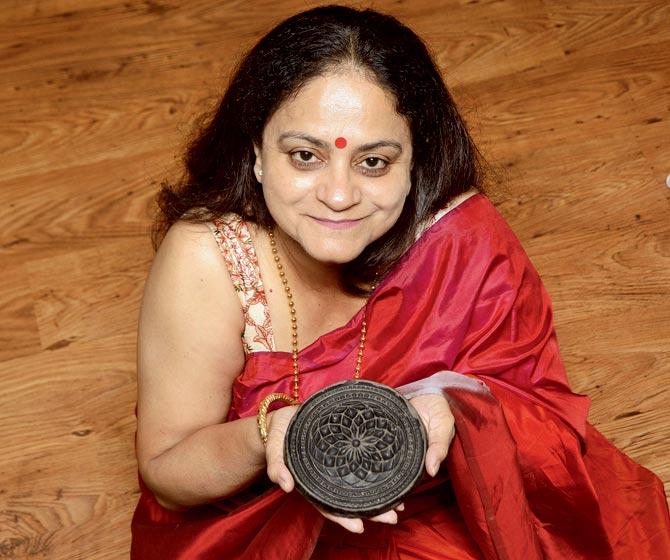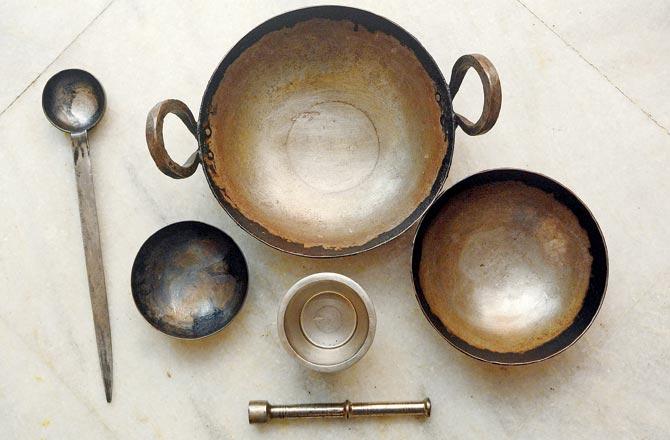Utensils passed down over generations, carry the added flavour of nostalgia

Anything old is often ascribed to memory. For this writer, it's the time spent in the dimly-lit kitchen of her grandmother, watching her vigorously crush and pound grated coconut and chillies on the stone grinder to prepare the tangy raw mango chutney that we enjoyed with dosa. And how she'd tug at the fiery broken tree barks clubbed inside the gaping hole of a brick stove, to control the billowing flames that threatened to blacken the large aluminum rice-cooking pot.
She never cooked rice on the gas stove. We never asked why. But living where she did, in a bucolic hinterland, surrounded by trees of all kinds with fruits of all shapes, food was always sourced from what she grew, and prepared as sustainably as possible. Modern appliances were not alien to her kitchen, but she was possessive about how she fed the family. It's this "possessiveness," passed down generations, that add value to items from old kitchens.

Wilfred Louis using his mum's teak wood coconut scrapper, which she brought with her from Kollam, Kerala, when they moved to Mumbai, then Bombay, in 1948. Pics/Ashish Raje
Mulund resident Mrinmayee Ranade's everyday meals are incomplete without a sabzi or tadka in one of the many heavy iron kadhais, a hand-me-down from her mother-in-law, who received it as a gift from her sister-in-law after she had used it for over two decades. It's been in her family for 70 years, but the Ranades could have owned it long before that, she says. For Ratnabali Datta Majumdar, it's the century-old sandesh moulds, a family heirloom from their ancestral home in Sylhet, Bangladesh, which has now found a pride of place in her Durga puja celebrations. As Shaili Sathyu who continues to use the stone grinder in her house, says, "While food is integral to our culture, the making of it is also important. It helps us stay connected with what that food represents. Sometimes food is not just about taste, it's also about how it all comes together."
A fountain of memories
The wooden coconut scraper at Wilfred Louis's Andheri home is not what one would immediately associate as something of heritage value. "There is nothing glamorous or ornate about it," he agrees, too. "The base is teak wood and the front portion is made of metal. Yet, despite looking so plain, it has a lot of character." While 55-year-old Louis isn't sure about the exact age of the appliance, he claims it's something his newly-married parents brought with them from Kollam, Kerala, when they moved to Mumbai, then Bombay, in 1948. His mum, Margaret Louis, called it the tenga chirava — tenga meaning coconut and chirava, scraper in Malayalam.

The table that theatre director Shaili Sathyu designed for the stone grinder, which her father brought with her from Mysore. Pic/Sameer Markande
"As a child, I was fascinated by it. I remember telling mum how I wanted to try grating coconut on it. But, because she was scared that I'd cut myself, she would hold my hand and we'd gently work our way through it," he recalls. She passed away four years ago. But, he still remembers the distinct sound of the grating of coconuts — unlike the modern electric scraper which is kept on the table, this is placed on the floor — early every morning.
"I'd be lying half asleep in bed and I would hear the 'krrrrr krrrr' [due to the scraping] emanating from the kitchen, and I knew that she'd be making steaming puttu [steamed cylinders of ground rice layered with coconut], or appam [pancake of rice batter and coconut milk] for breakfast." Still nostalgic about those times, he continues to use the scraper to this day, getting even his 28-year-old daughter to take a shine to it.

Majumdar's father's parents moved to West Bengal after the Partition, and among the many things they left behind in Bangladesh, then East Pakistan, was an aluminum bartan with stone and wooden moulds, used to prepare the Bengali dessert sandesh. Her grandmother managed to get it back to India, when a relative was visiting Sylhet. "That is how attached she was to it," says Majumdar. When her mum married into the family, they became hers. It was only a few years ago that Majumdar brought it to Mumbai from her parents' Kolkata home.
"In 2015, my mum came to live with me, and that's when, for the first time, I got her to teach me how to prepare sandesh. The sweet dish is made using milk, gur and sometimes chana dal. The ingredients are heated in a kadai and stirred continuously till it reaches the right consistency. After it's cooled, the mixture is placed in the moulds, greased with ghee. I remember her inspecting every bit of the preparation. She passed away last year, but I now continue the tradition. We make sandesh every Dashami and distribute it to friends, family as well as the Ram Krishna Mission," says Majumdar.

Ratna Majumdar with the stone and wooden sandesh moulds that her grandmother brought with her when she moved to India from Bangladesh during the Partition
Retaining old flavours
Ranade has five iron vessels in her kitchen — the heaviest weighs 1.6 kg. That doesn't dissuade her from using them. Sharing a 'nuska,' she says that when cooking in it, iron from the kadhai gets transferred into the food. "It helps fight iron-deficiency," she says. Just like Indians prefer their chai in kulhads over chinaware, she says, "I've prepared sabzis in all kinds of vessels, but the flavours of the ingredients soak in best, when you prepare meals in iron handis." The tadkas for dal, especially, have never been done in any other vessel.
Sathyu says the stone grinder in her house is an heirloom from her paternal aunt, who lived in Mysore. She gave it to her father, when her parents moved to Mumbai in the 1960s. In the mid 1990s, Sathyu who is a theatre director as well as an architect, designed a table for the grinder, so that one didn't have to squat down when using it. These days, their aunt, Sushila Bachan, 71, who lives with them, uses it mostly, when making dahi vada. "The vada batter requires a certain consistency, which my aunt feels only the stone grinder can best give. We also use it when grinding the stuffing for puran poli," says Sathyu.

The iron kadhais that Mrimayee Ranade got from her mother-in-law. Pics/Sneha Kharabe
For Mangala Rao, 60, a hoarder of sorts, the copper idli steamer with steel katoris — gifted to her mum, now 89, by her in-laws — is just one among the many antique utensils in her home. "Since we are South Indians, we make all kinds of idlis, right from the sweet ones to the savouries, comprising cabbage and pumpkin. These katoris are not as shallow as the new ones, and hence, can be used for the more complicated versions of the dish."
While elaborate cooking doesn't seem to pinch kitchens that boast of age-old paraphernalia, it's the upkeep that invites concern. Ranade, for instance, never leaves food in the iron pots, because it can react with the latter. After washing the kadhai, she dries it immediately under a fan, and applies a coat of oil on it, so that it doesn't rust. Louis never uses soap to wash the metal part of the grater, rinsing it only with water; Majumdar whose stone moulds have resisted wear and tear, has only had to worry about the wooden moulds, which are now disintegrating on the edges.

"It's a combination of nostalgia, love for rituals and our tradition that make me hold on to these objects," says Majumdar. They carry with them, the stories of our families, the food they ate and the lives they lived, she ends.
Catch up on all the latest Mumbai news, crime news, current affairs, and also a complete guide on Mumbai from food to things to do and events across the city here. Also download the new mid-day Android and iOS apps to get latest updates
 Subscribe today by clicking the link and stay updated with the latest news!" Click here!
Subscribe today by clicking the link and stay updated with the latest news!" Click here!









